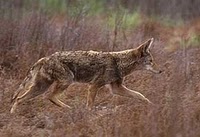So far, we have written several posts about our red wolves here. While most of them have discussed our wolves’ health, we have also shown some video of great interactions with enrichment, as well as talking about their annual physicals. However, there is an abundance of information to be shared about this critically endangered species, and a good place to start is with their history.

Red wolves (picture left) used to be one of the only large predators in the eastern United States, and their native habitat spanned from Pennsylvania down to Florida and as far west as Texas. Their presence in the wild was essential for keeping other wildlife populations healthy and balanced, such as white-tailed deer and raccoons. Unfortunately, red wolves were believed to be a nuisance to farmers who thought they were a danger to livestock, while others wanted to eradicate them simply out of fear for their own safety. These misconceptions eventually caused a bounty to be placed on them, meaning anyone that could prove they had killed a red wolf received a cash reward. The onset of increased hunting, coupled with loss of habitat and the threat of hybridization, forced this species to the brink of extinction. By the time the Endangered Species Act was started in 1967, wild red wolf sightings were few and far between. They were promptly added to the Endangered Species List, and throughout the 1970’s all of the remaining red wolves were collected from the wild to start a successful breeding program.

However, red wolves had begun breeding with coyotes (picture right) as their numbers depleted in the wild. This led to red wolf-coyote hybrids that had to be identified and removed from the remaining wild population. The result was 17 full-blooded red wolves, 14 capable of breeding, from which to pull the species back from near extinction. In fact, they were classified extinct in the wild by 1980.
Compare the two pictures above: do you notice the similarities between the coyote and red wolf? Look for a later post to learn how scientists managed to tell coyote hybrids apart from red wolves in the 1970’s when DNA testing was not available.
Red wolf photo courtesy of the U.S. Fish and Wildlife Service.
Coyote photo by Gary Kramer/ U.S. Fish and Wildlife Service.
This just shows how important it is to educate the public
Education is one of the biggest rewards I get from being a keeper. The real beauty of it is that I learn more and more every day, as well!
sorry about the abrupt comment I left…Igor, my cat, has yet again given his helping paws to assist me with my internet surfing…Last week it was the purchase of a camera and this week he is doing a little of his own blogging.
My girlfriend and I believe we saw a Red Wolf in Western NC just west of Wilksboro on Sunday (10/19). It came out of the woods to the edge of a horse field. It look a lot like a German Shepard. It was about 50 yrds away from us. It did not notice us at first. Once it saw us, it looked for about 2 seconds, then put his head down and trotted away. Does anyone know if there have been other sightings in Western NC?
Hi Michael,No red wolves in western NC. It is most likely that you saw a coyote- sometimes coyotes and red wolves can look very similar. Marilyn wrote about this in a July 12 post:http://mlsanimaldepartment.blogspot.com/2008/07/mistaken-identity-coyote-or-red-wolf
Hi. I photographed this creature in my backyard yesterday and I am not sure if it is a coyote, wolf, or a peculiar dog. Would you mind taking a look at it? Here is the link:http://www.thomastrails.blogspot.com/Thank you!
Thanks for your quick response to my post about our mystery creature. I live in North Raleigh is a densely populated residential area. We are north of Interstate 540. We enjoy a large deer population in this area – I normally see a dozen deer/daily and they bed down in my compost bed. I am worried that this wolf/coyote is a threat to them and our pets. I just posted a couple more pictures of him on the blog:http://www.thomastrails.blogspot.com/
Hello I am doing a report on wolves. I would like to know what ones are the best to do reports on? because I am doing it on all wolves. Can you give me some information on the wolves thank you I'll be back later to day
Anonymous: please call the Museum and ask for the animal department so we can help you with your report.You could also contact us through our website si we can get to you directly.